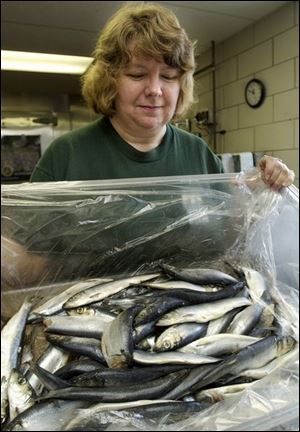
Zoo visitors soon will feast eyes on animal mealtime
4/21/2003
Julie Reynolds has prepared a meal in a bowl for the Gambel's quails at the Toledo Zoo: Among the apples, grapes, carrots, and leafy greens are live worms.
zapotosky / blade

Julie Reynolds has prepared a meal in a bowl for the Gambel's quails at the Toledo Zoo: Among the apples, grapes, carrots, and leafy greens are live worms.
At arm's length, it appears to be a delectable salad: plump purple grapes mingle with crunchy carrots and apple chunks on a crisp bed of greens.
But wait. Are those rice noodles actually moving?
Indeed, in an industry chock-full of weird jobs, a zoo's food service is among the weirdest. Those “noodles” are mealworms, the pieces de resistance in a nutritious salad for more than 50 South American and Asian flight birds at Toledo Zoo.
“A lot of our food looks very pretty,” said keeper Julie Reynolds, who prepares meals for the zoo's feathered residents. “Sometimes we use mango or papaya or blueberries or even flowers, but then you realize: Hey, this food is moving.”
Soon the public - or at least those whose curiosity comes with a strong stomach - will get a rare peek at what long has been an obviously critical but often behind-the-scenes slice of the zoo business: feeding the animals.
This summer the Toledo Zoo will offer natural feeding demonstrations. That means that keepers will give dead rabbits, rats, herring, and squid to the zoo's predators - reptiles, sharks, and perhaps wolves and birds of prey - while the public watches.
“People, I think, sometimes forget that these animals eat too, and it's not like we give them all a big bowl of dog food,” said Beverly Schoonover, who works in the zoo's commissary.
There, alongside the bananas and birdseed, are frozen cubes of dead chicks, a variety of rodents, a few dozen frozen guineas, ground-up horse meat, and often a calf or two.
Demonstrations begin May 24, and feeding schedules will be posted so visitors can choose whether they want to witness predatory snack time.

`People, I think, sometimes forget that these animals eat too, and it's not like we give them all a big bowl of dog food,' said zoo commissary steward Beverly Schoonover, with herring that will be fed to some of them.
Many of the zoo's animals already are fed in view of the public, but theirs is a diet much like ours: grapes and green beans, carrots and cantaloupe, even ketchup and mustard.
But for as much as the public wants to see exotic or rare beasts, they hadn't so much cared to see those animals munching on something equally as furry.
That's why, for example, rabbits are taken off the raptors' menu in the spring. Several years ago, a visitor complained that her child was traumatized after spying what he thought was the remains of the Easter bunny in the eagle exhibit.
So until recently, keepers generally have waited until near-closing before carting out the euthanized prey for wolves, big cats, and birds of prey.
Still, feeding the animals these days is about much more than simple nutrition for the animals. It's about entertainment, exercise, and intellectual stimulation.
Sam, the rhino, loves to mash up melon, and Renee, the elephant, lumbers after her apple-toting keepers. The great apes prefer Kool-Aid Popsicles or telephone books slathered with peanut butter or honey.
“We want them to work for their food,” said Beth Stark, animal behavioral manager at the zoo. “In the wild, most animals spend 50 percent of the day foraging for food.”
“Carcass feeding,” as it's called, encourages natural behavior in the animals. For example, after tearing into a meal, the zoo's four wolves spend much of their time grooming each other, she said.
Soon, the animals' diets might be about educating the public, too, she said.
Toledo Zoo keepers have introduced a couple of trial feedings, and so far, the public's reaction has been “100 percent positive,” Ms. Stark said.
In fact, other American zoos are also introducing public feedings - a trend long ago established in European zoos, said Kathy Carlstead, a research scientist at the Honolulu Zoo and a co-chairman of the behavior advisory group of American Zoo and Aquarium Association. “It can be startling, but it's also educational,” she said. “We're so far removed from it, but animals eat animals. That's always been there.”